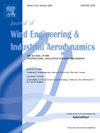Experimental investigation on self-excited vibration and wake interference effects of flexible photovoltaic systems
IF 4.9
2区 工程技术
Q1 ENGINEERING, CIVIL
Journal of Wind Engineering and Industrial Aerodynamics
Pub Date : 2025-04-07
DOI:10.1016/j.jweia.2025.106098
引用次数: 0
Abstract
The issues of wind-induced vibration (WIV) are major technical bottlenecks in the development of cable-supported photovoltaic (CSPV) systems. In the present study, series of aeroelastic model wind tunnel tests of CSPV systems were conducted to analyze the WIV characteristics and wake interference effects. The WIV of the CSPV system is accompanied by significant structural nonlinearity, which causes the increase in mean response and vibration amplitude to gradually slow down with increasing wind speed. And it leads to a linear increase in the dominant frequency of vibration in the CSPV system as wind speed increases. The wake interference effect of single row changes with the wind speed. And the wake interference effect under negative AOA has a more pronounced periodic excitation effect on the rear row compared with positive AOA. In the five-rows CSPV array, the wake interference effects are more significant under positive AOA. The wake formed by first two rows induces significant bending-torsional coupling vibrations in the third row. And the wake formed by first three rows induces significant vertical vibrations in the rear rows. The wake interference effects under negative AOA primarily causes torsional vibration of the two rows behind the windward row. However, the wake formed by the first three rows causes almost no vibration in the rear row. Based on the analysis results, a ground anchor cable was proposed as a wind-resistant measure for the CSPV system, and its effectiveness was verified through experiments.
柔性光伏系统自激振动及尾迹干扰效应实验研究
风致振动问题是影响索撑光伏发电系统发展的主要技术瓶颈。本文对CSPV系统进行了一系列气动弹性模型风洞试验,分析了CSPV系统的WIV特性和尾迹干扰效应。CSPV系统的WIV伴随着显著的结构非线性,导致平均响应和振动幅值的增加随风速的增加而逐渐放缓。随着风速的增大,CSPV系统的主导振动频率呈线性增加。单排的尾迹干扰效应随风速的变化而变化。与正AOA相比,负AOA下尾迹干涉对尾部的周期性激励效应更为明显。在五排CSPV阵列中,正AOA条件下尾迹干扰效应更为显著。前两排形成的尾迹在第三排引起了显著的弯曲-扭转耦合振动。由前三排形成的尾流在后排引起了明显的垂直振动。负AOA下尾迹干涉效应主要引起迎风排后两排的扭转振动。然而,由前三排形成的尾流在后排几乎没有引起振动。在分析结果的基础上,提出了地面锚索作为CSPV系统的抗风措施,并通过实验验证了其有效性。
本文章由计算机程序翻译,如有差异,请以英文原文为准。
求助全文
约1分钟内获得全文
求助全文
来源期刊
CiteScore
8.90
自引率
22.90%
发文量
306
审稿时长
4.4 months
期刊介绍:
The objective of the journal is to provide a means for the publication and interchange of information, on an international basis, on all those aspects of wind engineering that are included in the activities of the International Association for Wind Engineering http://www.iawe.org/. These are: social and economic impact of wind effects; wind characteristics and structure, local wind environments, wind loads and structural response, diffusion, pollutant dispersion and matter transport, wind effects on building heat loss and ventilation, wind effects on transport systems, aerodynamic aspects of wind energy generation, and codification of wind effects.
Papers on these subjects describing full-scale measurements, wind-tunnel simulation studies, computational or theoretical methods are published, as well as papers dealing with the development of techniques and apparatus for wind engineering experiments.

 求助内容:
求助内容: 应助结果提醒方式:
应助结果提醒方式:


